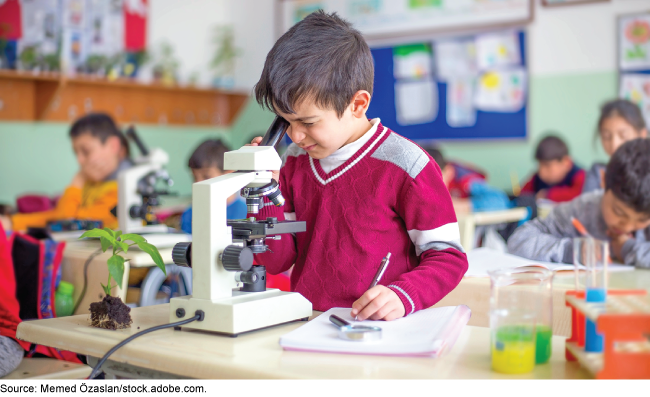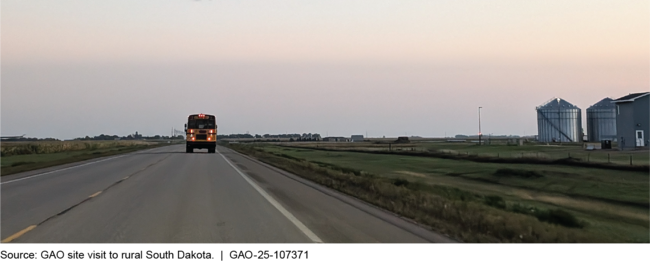STEM Education: Selected Federal Initiatives, Challenges, and Approaches to Supporting Rural Populations
Fast Facts
Some rural school districts struggle to provide science, technology, engineering, and mathematics (STEM) education. Many face challenges attracting certified teachers, accessing materials, and busing students to field trips far away. Yet some rural districts have found innovative ways to share resources, connect STEM lessons to local environments, and help students explore related careers. For example, some have teamed up with university research centers or nonprofits to access federally funded equipment and materials for STEM activities, like robotics. Other initiatives connected STEM activities to local careers, like beekeeping or farming.

Highlights
What GAO Found
All four federal agencies GAO selected for review generally reported supporting K-12 science, technology, engineering, and mathematics (STEM) education for rural populations as part of broader initiatives that served numerous populations. Agency officials provided examples of how these initiatives have supported rural STEM education in various ways. For example, some initiatives have supported recruiting and training STEM educators. Other initiatives have focused on enhancing STEM learning and career exploration for students in rural schools, such as through educational field trips and hands-on activities.
School and district officials GAO visited in Alabama, Maine, Nevada, and South Dakota said that staffing challenges and limited access to STEM learning opportunities and materials were barriers to providing K-12 STEM education in rural areas. For example, officials from one district in rural Alabama said their district had no certified math teachers to serve their 300 students in grades seven through 12 in the 2023-24 school year. Stakeholders also said the cost and logistics of traveling long distances in remote rural areas limited opportunities for certain field trips or learning activities. Rural districts GAO visited varied in terms of remoteness and size and experienced these challenges differently.
Remoteness and Transportation Costs Can Limit Access to Learning Opportunities

School and district officials in the four states GAO visited said that improving access to STEM learning materials and showing students how STEM topics related to their lives were among the ways they effectively supported rural K-12 STEM education. In many cases, their efforts were made possible by partnering with groups such as university research centers, nonprofit organizations, and local employers. To improve access to STEM materials, rural stakeholders highlighted strategies such as using federal funds to purchase equipment and sharing materials across rural districts. For example, a federally-funded research institute in Nevada maintains a robotics lending library and ships STEM materials to teachers in rural schools throughout the state. Stakeholders also consistently highlighted the value of connecting STEM activities to students' local environments, like projects related to beekeeping and growing vegetables in South Dakota, to spark students' interest in STEM.
Why GAO Did This Study
STEM education helps prepare K-12 students for careers in STEM fields to enhance innovation and global competitiveness. About 10 million K-12 students were enrolled in public schools in rural areas in 2022, the most current year of data available.
The August 2022 Research and Development, Competition, and Innovation Act includes a provision for GAO to examine issues related to rural STEM education. This report describes (1) selected federal agencies' initiatives that support rural K-12 STEM education, (2) challenges selected recipients of federal funds and other stakeholders have reported related to supporting rural K-12 STEM education, and (3) approaches selected recipients of federal funds have found to be effective for supporting rural K-12 STEM education.
To conduct this work, GAO examined federal initiatives that support rural K-12 STEM education at four agencies— the Department of Agriculture, Department of Education, National Aeronautics and Space Administration, and National Science Foundation. GAO selected these agencies in part based on the number of K-12 STEM education initiatives they administered and their STEM education funding levels as of fiscal year 2022, the most recent year for which data were available when selected. GAO also visited rural school districts in four states—Alabama, Maine, Nevada, and South Dakota—selected to include a variety of geographic regions and rural district characteristics. GAO also interviewed stakeholders from national organizations and local employers in the four states and reviewed relevant federal laws and regulations.
For more information, contact Melissa Emrey-Arras at emreyarrasm@gao.gov.
